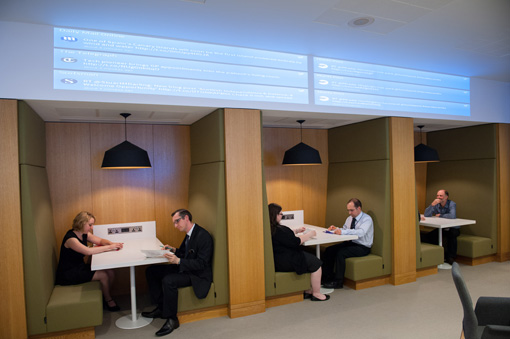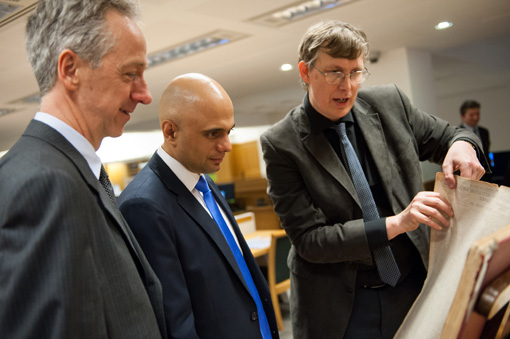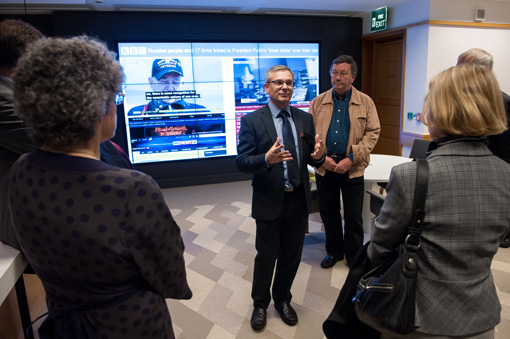In April 2014 the British Library opened its reading room for news. Its many features include a Broadcast News service with a growing library of recordings from 22 television and radio news channels. Dr Luke McKernan looks beyond the headlines.
 About the author: Luke McKernan is Lead Curator, News and Moving Image at the British Library. He is the author of: Charles Urban: Pioneering the Non-Fiction Film in Britain and America, 1897-1925 (University of Exeter Press, 2013); Shakespeare on Film, Television and Radio: The Researcher’s Guide (BUFVC, 2009), co-editor with Eve-Marie Oesterlen and Olwen Terris; Moving Image Knowledge and Access: The BUFVC Handbook (BUFVC, 2007), co-editor with Cathy Grant; Yesterday’s News: The British Cinema Newsreel Reader (BUFVC, 2002), editor; A Yank in Britain: The Lost Memoirs of Charles Urban, Film Pioneer (The Projection Box, 1999), editor; Who’s Who of Victorian Cinema: A Worldwide Survey (BFI, 1996), co-editor with Stephen Herbert; Walking Shadows: Shakespeare in the National Film and Television Archive (BFI, 1994), co-editor with Olwen Terris.
About the author: Luke McKernan is Lead Curator, News and Moving Image at the British Library. He is the author of: Charles Urban: Pioneering the Non-Fiction Film in Britain and America, 1897-1925 (University of Exeter Press, 2013); Shakespeare on Film, Television and Radio: The Researcher’s Guide (BUFVC, 2009), co-editor with Eve-Marie Oesterlen and Olwen Terris; Moving Image Knowledge and Access: The BUFVC Handbook (BUFVC, 2007), co-editor with Cathy Grant; Yesterday’s News: The British Cinema Newsreel Reader (BUFVC, 2002), editor; A Yank in Britain: The Lost Memoirs of Charles Urban, Film Pioneer (The Projection Box, 1999), editor; Who’s Who of Victorian Cinema: A Worldwide Survey (BFI, 1996), co-editor with Stephen Herbert; Walking Shadows: Shakespeare in the National Film and Television Archive (BFI, 1994), co-editor with Olwen Terris.
On 28 April 2014 the British Library officially launched the Newsroom, its reading room for news at its St Pancras site in London. The Newsroom is the culmination of a seven-year programme to preserve the nation’s newspaper collection long term. It also point to the Library’s future plans for news, as it brings together not only a vast newspaper archive but also its growing collections of television, radio and web news.
In 2001 a survey of the British Library’s newspaper collections, then held at Colindale in North London, revealed that the collection was in a highly vulnerable state. 34% of the collection was assessed as being unstable, with 19.4% in poor condition and 14.6% in an unusable state. There were no proper temperature or humidity controls, sunlight streamed through the windows and the conditions were seasonal. Newspapers, produced for the most part on cheap newsprint never designed to last more than a day, let alone centuries, were crumbling before our eyes.

Launch of the Newsroom at The British Library.28 April 2014 (Image © The British Library)
It was not a situation that could be allowed to continue and it led to a major planning exercise followed by a funding application to the Department of Culture, Media and Sport, out of which came the £33M Newspaper Programme. Wind forward to 2014, and the Programme is nearly complete. The Newspaper Storage Building (NSB) at Boston Spa has been built and is designed to hold all sixty million issues of newspapers that the Library has going back to the early seventeenth century, with room for growth as we continue to take in over 300 metres of newspapers per year. The Colindale library building closed down in November 2013 and the newspapers are now in the process of being transported up to Yorkshire in large lorries, three per day every day until Autumn 2014, when they will be ready for access once more.
However, access means only when there is no microfilm or digital copy available, as we need to protect the print newspapers. Fortunately a third of the collection has been microfilmed, and all the microfilms (625,000 reels) are now stored in the basements at St Pancras, available to users within seventy minutes. We have also digitised nearly eight million pages (out of 450 million newspaper pages that we estimate we hold) via an agreement with DC Thomson Family History, who make these available via the subscription site the British Newspaper Archive - the target is to reach forty million pages by 2020. Only when we cannot provide a microfilm or digital copy will we provide a print copy, for which there will be a forty-eight-hour turnaround. We will also be providing access to the print newspapers and digital version at our Boston Spa reading room, but not to the microfilm copies, which remain in London.
The Newsroom, formally launched on 28 April by the Secretary of State for Culture Sajid Javid, is in two sections. An antechamber, informally called the networking area, is open to anyone. It comes equipped with many charging points (making the space instantly popular, along with the free Wi-Fi), a video wall showing live TV and web news, and two Twitter feeds showing tweets posted by the news websites that we archive. It is a space designed for collaborative research - and makes the point that we are about today’s news as much as yesterday’s, our understanding of news extending beyond newspapers.
The reading room itself is open to anyone with a British Library reader’s pass. The reading room has 110 desks, of which forty have specialist digital microfilm readers that enable users to view microfilm or electronic resources on the same, adjustable screen while eight have dedicated electronic resource terminals. There are fifteen microfilmed national newspaper titles which are available in their on open access, including the Daily Mail (1896-2009); The Guardian (1821 onwards); News of the World (1843-2011); Sun (1964-2009), and The Times (1785 onwards). The electronic resources also include access to hundreds of digitised newspaper resources from around the world, all free to use for British Library readers.

Launch of the Newsroom at The British Library.
Secretary of State for Culture, Media and Sport, Sajid Javid, takes a tour of the Newsroom with Chief Executive of the British Library, Roly Keating and Curator, Luke McKernan.
An important step forward for us is audiovisual news offering that we can now make. The Library’s news offering aims now to incorporate the full range of news media – newspapers, news websites, television news, radio news, and other media – through a combination of legal deposit, purchase and voluntary deposit, capture through copyright exception, and connecting to both licensed content and content shared with strategic partners.
Hence every terminal in the Newsroom is equipped with headphones to offer our Broadcast News service. This records and delivers access to television and radio news programmes from twenty-two channels receivable free-to-air in the UK. Recordings began officially on 6 May 2010 (General Election day). There are now over 40,000 programmes available, with around sixty hours added each day, available immediately after broadcast.
We currently record from the following channels:
- Television: Al Jazeera English, BBC One, BBC Two, BBC Four, BBC News, BBC Parliament, Bloomberg, Channel 4, CNN, CCTV News, France 24, ITV1, NHK World, Russia Today/RT, Sky News
- Radio: BBC London, BBC Radio 1, BBC Radio 4, BBC Five Live, BBC World Service, LBC, talkSport
British Library users can search for and view the programmes in the Newsroom, or in any Reading Room at a terminal where headphones are provided. Innovative searching across subtitles, where these are available, makes the news programmes word-searchable and opens them up to a wide range of research enquiries. Due to copyright restrictions, we are currently unable to provide online access to the collection. We record the same programmes each day, while picking up on new programmes of interest as they appear. We have also made more extensive recordings of major breaking news stories, such at the London riots of 2011, the Japanese tsunami, and the death of Nelson Mandela, where we produce full twenty-four-hour coverage from at least two channels, for purposes of comparison and to avoid any bias.

Launch of the Newsroom at The British Library.28 April 2014 (Image © The British Library)
We are also offering access to BBC television and radio programmes via the BBC catalogue service. This bespoke offering draws in over two million BBC catalogue records going back to the 1950s from various sources, plus playable programmes from 2007 onwards. As with Broadcast News it is available onsite only.
Equally important are our web news holdings. Our Legal Deposit UK Web Archive includes millions of websites obtained through our annual archiving of the entire UK domain, initiated in 2013 following the introduction of legal deposit legislation covering electronic publications and websites. As well as the annual archive of UK websites (which includes many news-based sites), we have been archiving selected UK news sites on a daily or weekly basis since September 2013.
We have selected an initial 500 websites, including those produced by newspapers, news broadcasters, and news services developed independently for the web, with an even geographical spread across the UK. The sites we are archiving include Huffington Post, BBC News, Wales Online, The Exeter Daily, The Northern Echo and The Voice. A further significant tranche will be added in summer 2014, including many 'hyperlocal' news sites that document news stories about and often produced by local communities across the UK. The Legal Deposit UK Web Archive may only be accessed on British Library terminals.
The Newsroom is the physical expression of where we want to go with news. Our core business remains newspapers, but we want to reflect the full range of news media which are produced in the UK or which have had an influence on perceptions of news in the UK. The Newsroom name itself applies to any news medium, and suggests a place where knowledge is created as much as it is gathered in. Our task for the future will be not only to collect these different news forms, but also to show the connections between them. The medium itself should not matter; it is the news, and all that we as researchers can do with it, that is important.
Luke McKernan
Further information
- www.bl.uk/subjects/news-media
- http://britishlibrary.typepad.co.uk/thenewsroom/
- www.britishnewspaperarchive.co.uk